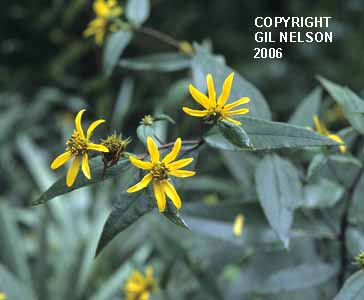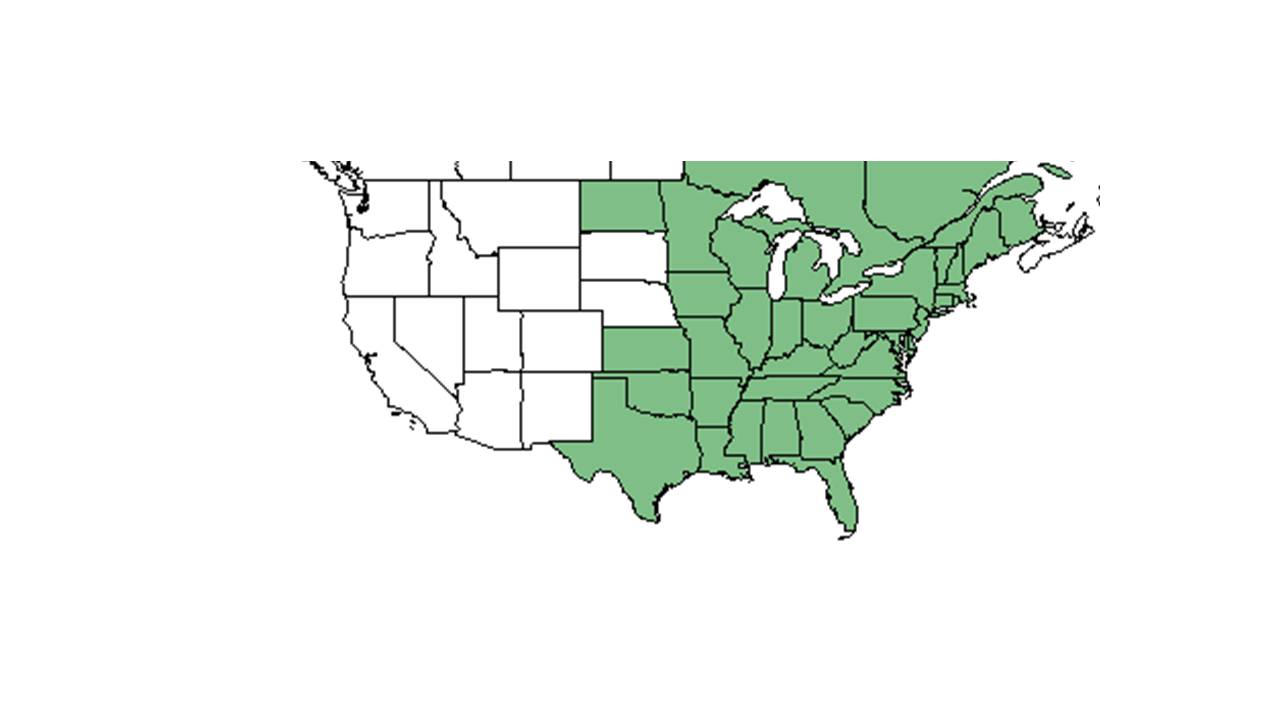Difference between revisions of "Helianthus strumosus"
Krobertson (talk | contribs) (→Description) |
Adam.Vansant (talk | contribs) |
||
| (18 intermediate revisions by 7 users not shown) | |||
| Line 18: | Line 18: | ||
}} | }} | ||
| − | Common | + | Common names: paleleaf woodland sunflower; roughleaf sunflower |
==Taxonomic notes== | ==Taxonomic notes== | ||
| − | Synonyms: ''Helianthus montanus'' E.E. Watson; ''H. saxicolus'' | + | Synonyms: none<ref name=weakley>Weakley, A.S. 2020. Flora of the Southeastern United States. Edition of 20 October 2020. University of North Carolina at Chapel Hill, Chapel Hill, North Carolina.</ref> |
| + | |||
| + | Varieties: ''Helianthus montanus'' E.E. Watson; ''H. saxicolus''<ref name=weakley/> | ||
==Description== | ==Description== | ||
| Line 29: | Line 31: | ||
==Distribution== | ==Distribution== | ||
| + | The distribution of this plant ranges from Maine, west to Minnesota and Kansas, and south to Panhandle Florida and Texas.<ref name=weakley/> | ||
| + | |||
==Ecology== | ==Ecology== | ||
===Habitat=== <!--Natural communities, human disturbed habitats, topography, hydrology, soils, light, fire regime requirements for removal of competition, etc.--> | ===Habitat=== <!--Natural communities, human disturbed habitats, topography, hydrology, soils, light, fire regime requirements for removal of competition, etc.--> | ||
| − | ''H. strumosus'' occurs in drier, well-drained uplands, including sandy ridges, shaly slopes of oak-pine woods, crests of limestone bluffs, prairie over chalk, pine woodlands, and rocky embankments<ref name=fsu/> | + | ''H. strumosus'' occurs in drier, well-drained uplands, including sandy ridges, shaly slopes of oak-pine woods, crests of limestone bluffs, prairie over chalk, pine woodlands, and rocky embankments.<ref name=fsu/> It also seems to prefer higher light conditions, occurring in clearings and edges of woodlands, and other open, sunny locations. In addition to more rocky soils, it can be found in sandy silt, sandy clay, or sandy loam. This species also occurs in disturbed habitat, including roadsides, power line corridors, and semi-cleared woodlands. Associated species include Longeleaf pine and Oak species.<ref name=fsu/> ''H. strumosus'' was found to be an increaser in its long-term response following cessation of repeated soil disturbance.<ref name=Dixon>Dixon, C. M., K. M. Robertson, A. M. Reid and M. T. Rother. 2024. Mechanical soil disturbance in a pine savanna has multiyear effects on plant species composition. Ecosphere 15(2):e4759.</ref> |
===Phenology=== <!--Timing off flowering, fruiting, seed dispersal, and environmental triggers. Cite PanFlora website if appropriate: http://www.gilnelson.com/PanFlora/ --> | ===Phenology=== <!--Timing off flowering, fruiting, seed dispersal, and environmental triggers. Cite PanFlora website if appropriate: http://www.gilnelson.com/PanFlora/ --> | ||
| − | + | ''Helianthus strumosus'' has been observed flowering in August<ref>Nelson, G. [http://www.gilnelson.com/ PanFlora]: Plant data for the eastern United States with emphasis on the Southeastern Coastal Plains, Florida, and the Florida Panhandle. www.gilnelson.com/PanFlora/ Accessed: 19 MAY 2021</ref>. Fruiting has been observed in July and August.<ref name=fsu/> | |
<!--===Seed dispersal===--> | <!--===Seed dispersal===--> | ||
<!--===Seed bank and germination===--> | <!--===Seed bank and germination===--> | ||
===Fire ecology=== <!--Fire tolerance, fire dependence, adaptive fire responses--> | ===Fire ecology=== <!--Fire tolerance, fire dependence, adaptive fire responses--> | ||
| − | This species has been found in annually burned pine woodlands<ref name=fsu/>. | + | This species has been found in annually burned pine woodlands<ref name=fsu/> such as the Wade Tract in south Georgia where populations of ''Helianthus strumosus'' have been known to persist through repeated annual burns.<ref>Glitzenstein, J. S., D. R. Streng, R. E. Masters, K. M. Robertson and S. M. Hermann 2012. Fire-frequency effects on vegetation in north Florida pinelands: Another look at the long-term Stoddard Fire Research Plots at Tall Timbers Research Station. Forest Ecology and Management 264: 197-209.</ref> |
| − | < | + | |
| − | <!--=== | + | ===Pollination=== |
| + | ''Helianthus strumosus'' has been observed to host ground-nesting bees such as ''Andrena aliciae'' (family Andrenidae), bees such as ''Melissodes illata'' (family Apidae), and aphids from the family Aphididae such as ''Aphis sp.'' and ''Uroleucon sp.''.<ref>Discoverlife.org [https://www.discoverlife.org/20/q?search=Bidens+albaDiscoverlife.org|Discoverlife.org]</ref> | ||
| + | <!--===Herbivory and toxicology===--> | ||
<!--===Diseases and parasites===--> | <!--===Diseases and parasites===--> | ||
| − | ==Conservation and | + | ==Conservation, cultivation, and restoration== |
| + | |||
| + | ==Cultural use== | ||
| + | Native Americans used the ground plants in baking, and they used the seeds as a decongestant and crushed roots on bruises.<ref> Korchmal, Arnold & Connie. 1973. A Guide to the Medicinal Plants of the United States. The New York Times Book Company, New York.</ref> | ||
| − | |||
==Photo Gallery== | ==Photo Gallery== | ||
<gallery widths=180px> | <gallery widths=180px> | ||
Latest revision as of 13:19, 2 August 2024
| Helianthus strumosus | |
|---|---|

| |
| Photo was taken by Gil Nelson | |
| Scientific classification | |
| Kingdom: | Plantae |
| Division: | Magnoliophyta - Flowering plants |
| Class: | Magnoliopsida – Dicotyledons |
| Order: | Asterales |
| Family: | Asteraceae ⁄ Compositae |
| Genus: | Helianthus |
| Species: | H. strumosus |
| Binomial name | |
| Helianthus strumosus L. | |

| |
| Natural range of Helianthus strumosus from USDA NRCS Plants Database. | |
Common names: paleleaf woodland sunflower; roughleaf sunflower
Contents
Taxonomic notes
Synonyms: none[1]
Varieties: Helianthus montanus E.E. Watson; H. saxicolus[1]
Description
A description of Helianthus strumosus is provided in The Flora of North America.
Helianthus strumosus is a perennial herbaceous species. It is colonial, with perennating rhizomes. This species also tends to be a taller species, with stems up to two meters long.[2]
Distribution
The distribution of this plant ranges from Maine, west to Minnesota and Kansas, and south to Panhandle Florida and Texas.[1]
Ecology
Habitat
H. strumosus occurs in drier, well-drained uplands, including sandy ridges, shaly slopes of oak-pine woods, crests of limestone bluffs, prairie over chalk, pine woodlands, and rocky embankments.[2] It also seems to prefer higher light conditions, occurring in clearings and edges of woodlands, and other open, sunny locations. In addition to more rocky soils, it can be found in sandy silt, sandy clay, or sandy loam. This species also occurs in disturbed habitat, including roadsides, power line corridors, and semi-cleared woodlands. Associated species include Longeleaf pine and Oak species.[2] H. strumosus was found to be an increaser in its long-term response following cessation of repeated soil disturbance.[3]
Phenology
Helianthus strumosus has been observed flowering in August[4]. Fruiting has been observed in July and August.[2]
Fire ecology
This species has been found in annually burned pine woodlands[2] such as the Wade Tract in south Georgia where populations of Helianthus strumosus have been known to persist through repeated annual burns.[5]
Pollination
Helianthus strumosus has been observed to host ground-nesting bees such as Andrena aliciae (family Andrenidae), bees such as Melissodes illata (family Apidae), and aphids from the family Aphididae such as Aphis sp. and Uroleucon sp..[6]
Conservation, cultivation, and restoration
Cultural use
Native Americans used the ground plants in baking, and they used the seeds as a decongestant and crushed roots on bruises.[7]
Photo Gallery
References and notes
- ↑ 1.0 1.1 1.2 Weakley, A.S. 2020. Flora of the Southeastern United States. Edition of 20 October 2020. University of North Carolina at Chapel Hill, Chapel Hill, North Carolina.
- ↑ 2.0 2.1 2.2 2.3 2.4 Florida State University Robert K. Godfrey Herbarium database. URL: http://herbarium.bio.fsu.edu. Last accessed: June 2014. Collectors: John B. Nelson, S. Bennett, John W. Thieret, H. R. Bennett, Robert Kral, Mabel Kral, D. S. Correll, H. E. Ahles, J. A. Duke, G. W. Parmelee, Mary E. Wharton, Robert F. Thorne, Scott McCoy, R. Kral, Delzie Demaree, Martha Lee, Dan Pittillo, _ Anderson, Tom S. Cooperrider, Norlan C. Henderson, Sidney McDaniel, Michael B. Brooks, Valerie Lumpkin, Kent D. Perkins, Fred Neal, R.K. Godfrey, Douglas Gage, D. S. Correll, R. A. Norris, Angela M. Reid, K. M. Robertson, and Loran C. Anderson. States and Counties: Arkansas: Phillips. Florida: Alachua, Leon, Liberty, and Madison. Georgia: Clarke. Illinois: Cook. Indiana: Newton. Iowa: Dickinson and Jones. Kentucky: Rockcastle. Louisiana: Bienville, Jackson, Natchitoches, Sabine, and Washington. Maryland: Baltimore. Michigan: Oakland. Mississippi: Chickasaw, Forrest, and Oktibbeha. Missouri: Jackson. North Carolina: Iredell and Macon. South Carolina: Sumter and Union. Tennessee: Wayne. Texas: Upshur. Virginia: Alleghany and Giles.
- ↑ Dixon, C. M., K. M. Robertson, A. M. Reid and M. T. Rother. 2024. Mechanical soil disturbance in a pine savanna has multiyear effects on plant species composition. Ecosphere 15(2):e4759.
- ↑ Nelson, G. PanFlora: Plant data for the eastern United States with emphasis on the Southeastern Coastal Plains, Florida, and the Florida Panhandle. www.gilnelson.com/PanFlora/ Accessed: 19 MAY 2021
- ↑ Glitzenstein, J. S., D. R. Streng, R. E. Masters, K. M. Robertson and S. M. Hermann 2012. Fire-frequency effects on vegetation in north Florida pinelands: Another look at the long-term Stoddard Fire Research Plots at Tall Timbers Research Station. Forest Ecology and Management 264: 197-209.
- ↑ Discoverlife.org [1]
- ↑ Korchmal, Arnold & Connie. 1973. A Guide to the Medicinal Plants of the United States. The New York Times Book Company, New York.